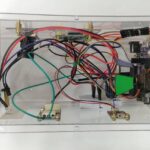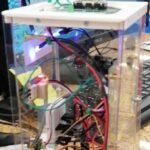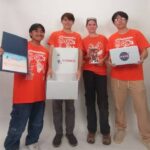Kealakehe High School had the only team in the state that was chosen to participate in this year’s NASA TechRise Student Challenge, a nationwide contest to engage students in technology, science and space exploration.
NASA on Jan. 21 announced 60 winning teams nationwide for its fourth TechRise Student Challenge. Teams were required to turn in a proposed science and technology experiment that will be conducted by a NASA-sponsored flight test this summer.
In August last year, the challenge opened for submissions to students in grades six to 12 from U.S. public, private and charter schools, including schools in U.S. territories. The winning teams include more than 530 students.
Upon completion, experiments will fly on a high-altitude balloon operated by World View Enterprises in Tucson, Ariz.
Winning proposals range from science, technology, engineering and math challenges, including: studying ozone levels; volatile organic compounds; testing the effects of radiation on different materials; and using environmental sensors to gather data for Earth-observation experiments.
Each team received $1,500 to build their experiments, a flight box to house it, technical support from engineering professionals, and an assigned spot for their experiments on the flight test.
During the test, experiments will experience around four hours of flight time at about 70,000 feet, with exposure to Earth’s upper atmosphere, high-altitude radiation and views of Earth.
NASA officials said the experiments at that altitude will experience the stratosphere’s unique thermal and atmospheric environment, providing conditions that ground-based testing cannot replicate.
The high-altitude balloon also will allow “payloads” to observe the surface below and collect data on land features such as vegetation and bodies of water.
The four available team members from Kealakehe High School were excited to share with West Hawaii Today what their experiences have been like since being selected and what they want to gain out of the challenge.
“Our experiment is analyzing the relationship between temperature inversions and ozone levels in the atmosphere,” Kealakehe’s TechRise project team manager and high school senior Ruby Jones said. “Temperature inversion is when you go up in the atmosphere, and temperature will go down and will get colder, but sometimes there are blips in that and you sometimes see a spike in temperature where really as you’re going up it should be dropping.
“We’re trying to see if there’s a correlation between if higher ozone levels in the atmosphere are contributing to that and how we as humans might be contributing to the ozone levels that might be causing that in our atmosphere because temperature inversions are not something we want and we are seeing an influx of that,” Jones added.
The team currently is working with NASA mentors and engineers to guide the experiment, help order parts and create the test box that will eventually be put on the NASA weather balloon.
“It’s interesting, because we’re getting through the design process with NASA engineers who know specific design details, and it’s very different from designing in lower elevations because this weather balloon will be up to 50,000 feet, and that brings with us some challenges,” Kealakehe team member and high school junior Sei Smith said.
“We’ve learned that certain memory chips and microchips aren’t effective at those altitudes so that’s something we’ve learned from NASA engineers as well as trying to keep that consistency and redundancy. There’s so many good things I can bring to my life as well as from learning from this project.”
“I think it’s so important that we’re in this kind of competition, especially as we’re the only Hawaii team,” Kealakehe team member and high school sophomore Lanz Vitales said. “We have a lot more challenges to come over with things like shipping times as well as not having the resources other teams might have because we are isolated in the middle of the ocean. We have a lot of problems trying to get things on time. With our payload, we’re trying to build this up and trying to get over these engineering challenges, and I think it’s really cool to see the organization and the team work that it takes to go through all this stuff with NASA’s help.”
The TechRise Student Challenge is designed to inspire a deeper understanding of Earth’s atmosphere, surface features and climate. It also provides students the opportunity to learn more about space exploration, coding, electronics and the value of test data.
“Currently it’s our third week in this build challenge and I really appreciate NASA engineers for taking their time out of their day to support this challenge and guide us all along,” Kealakehe team member and high school junior Daniel Chen said. “I feel like a lot of students invited to this wouldn’t be the most prepared in creating these parts and design needs for their satellite. I feel like NASA’s support throughout this journey is going to be really helpful.”
The challenge is led by NASA’s Flight Opportunities program, which demonstrates technologies for space exploration and the expansion of space commerce through suborbital testing with industry flight providers.
Kealakehe’s team also shared with West Hawaii Today about future goals and what they hope to achieve after graduating high school.
Jones said she applied to a
few different colleges and her plans for the fall is to major in biology or microbiology because she is interested in “working with pathogens, particularly bacteria in the future.”
Smith said he isn’t sure exactly what he wants to do, but he wants to go to college and pursue engineering in the best place he can go.
“I really want to pursue engineering. I feel like it’s a sore spot in Hawaii being able to have those high-tech industries and that’s something I want to learn going to college on the mainland somewhere and bring it back to Hawaii,” he said.
Vitales said he also wants to go into engineering and he has been fond of STEM for a long time.
“One thing I wanted to do is go into engineering, and my goal with that is to make something better. My dream college is MIT, and I just want to strive toward that with my engineering,” Vitales said.
Chen said he wants to pursue engineering because it’s something he has been interested in since he was a small child.
“I like the way things work and interact together. It’s really interesting to me and it’s definitely a future I want to pursue,” Chen said.
The following is a timeline of the challenge:
• Jan. 27 to 31, team meetings begin;
• Feb. 3 to May 13, virtual weekly engineering meetings;
• May 13, winner showcase and;
• May 14, mail in finished experiment-payload to Future Engineers.
In association with NASA, Future Engineers hosts online innovation challenges for elementary to high school students around the country.











